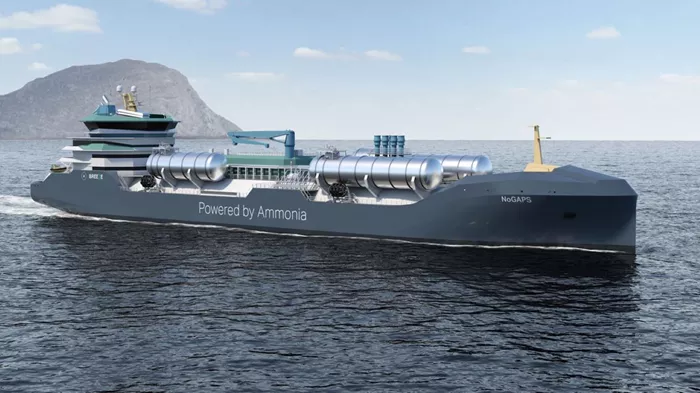As container ships traverse oceans, their massive diesel engines emit significant pollutants, contributing to climate change and adversely affecting human health. Maritime shipping is responsible for nearly 3% of global carbon dioxide emissions, and its air quality impacts cause around 100,000 premature deaths annually.
Decarbonizing the shipping industry to mitigate these harmful effects is a key goal of the International Maritime Organization (IMO), a United Nations agency regulating maritime transport. One proposed solution is to switch the global fleet from fossil fuels to sustainable alternatives like ammonia, which can be nearly carbon-free when considering its production and usage.
However, a new study by an interdisciplinary team from MIT and other institutions warns that using ammonia as maritime fuel could worsen air quality and have severe public health consequences unless implemented with stringent emissions regulations.
Ammonia combustion generates nitrous oxide (N2O), a greenhouse gas approximately 300 times more potent than carbon dioxide. It also releases nitrogen oxides (NO and NO2, collectively known as NOx) and may emit unburnt ammonia, which forms fine particulate matter in the atmosphere. These particles can penetrate deep into the lungs, causing health issues such as heart attacks, strokes, and asthma.
The study reveals that, under current legislation, transitioning to ammonia fuel could result in up to 600,000 additional premature deaths annually. However, with enhanced regulations and cleaner engine technology, the switch could reduce premature deaths by about 66,000 compared to current maritime shipping emissions, with a significantly lower impact on global warming.
“Not all climate solutions are created equal. We must adopt a holistic approach, considering all costs and benefits of various climate solutions, not just their decarbonization potential,” says Anthony Wong, the study’s lead author and a postdoctoral researcher at MIT’s Center for Global Change Science.
The co-authors include Noelle Selin, an MIT professor, Sebastian Eastham, a senior lecturer at Imperial College London, Christine Mounaïm-Rouselle from the University of Orléans, Yiqi Zhang from the Hong Kong University of Science and Technology, and Florian Allroggen, a research scientist at MIT. Their research appears in Environmental Research Letters.
Traditional ammonia production involves extracting hydrogen from natural gas and combining it with nitrogen at high temperatures, resulting in a substantial carbon footprint. The maritime industry is now focusing on “green ammonia,” produced using renewable energy for hydrogen extraction via electrolysis and heat generation.
“In theory, burning green ammonia in ship engines results in nearly zero carbon emissions,” Wong explains.
Nevertheless, even the greenest ammonia produces N2O and NOx when burned, with potential unburnt ammonia emissions. This N2O would linger in the atmosphere for over a century, while nitrogen emissions would harm delicate ecosystems and generate additional N2O through bacterial processes.
NOx and ammonia emissions also combine with other gases to form fine particulate matter, a major air pollution contributor causing an estimated 4 million deaths annually.
“Labeling ammonia as a ‘clean’ fuel is misleading. Being carbon-free does not equate to being clean and beneficial for public health,” Wong states.
To present a comprehensive view, the researchers designed scenarios to measure pollutant impacts under various technological and policy conditions.
Technologically, they considered two types of ship engines: one burning pure ammonia, emitting higher unburnt ammonia but fewer NOx, and another mixing ammonia with hydrogen to enhance combustion and catalytic converter performance, reducing both NOx and unburnt ammonia emissions.
They also analyzed three policy scenarios: current regulations limiting NOx emissions in certain regions, a scenario with ammonia emission limits over North America and Western Europe, and a global limit on ammonia and NOx emissions.
Using a ship track model, they calculated pollutant emission changes under each scenario, feeding the results into an air quality model to assess particulate matter and ozone pollution impacts. Finally, they estimated global public health effects.
One major challenge was the lack of real-world data, as ammonia-powered ships are not yet operational. The researchers utilized experimental ammonia combustion data from collaborators to build their model.
“We had to devise innovative methods to make the data useful and relevant for both technological and regulatory contexts,” Wong says.
Ultimately, they found that with no new regulations and pure ammonia-burning engines, switching the entire fleet could cause 681,000 additional premature deaths annually.
“While a scenario without new regulations is unlikely, it highlights the potential dangers of ammonia emissions. Unlike NOx, ammonia emissions from shipping are currently unregulated,” Wong notes.
Conversely, using cleaner engine technology without new regulations could reduce premature deaths to around 80,000, about 20,000 fewer than current maritime emissions. With robust global regulations and cleaner technology, air pollution-related deaths from shipping could decrease by approximately 66,000.
“The study underscores the need for policy development alongside new technologies,” Selin emphasizes. “Ammonia can be beneficial for climate and air quality, but regulations must address all potential impacts, including both climate and air quality.”
Ammonia’s air quality impacts would not be evenly distributed globally, necessitating coordinated strategies across different regions. Most premature deaths would occur in East Asia due to less stringent air quality regulations and higher existing pollution levels, which increase particulate matter formation from ammonia emissions. Additionally, East Asia’s heavy shipping volume exacerbates these negative effects.
Future research will aim to refine these findings and encourage the marine industry to share engine data for better evaluation of air quality and climate impacts. The researchers also hope to inform policymakers about the urgency of updating shipping emission regulations.
This research was funded by the MIT Climate and Sustainability Consortium.
Related topic:
- VA Health Chat Now Available Across All 18 VISNs
- Nearly 1.8 Billion Adults at Risk Due to Insufficient Physical Activity
- New Study Links Certain Emulsifiers to Higher Risk of Type 2 Diabetes


